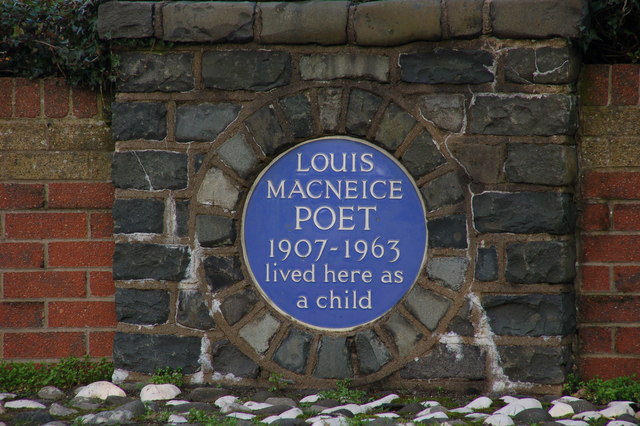Carrickfergus (poem) on:
[Wikipedia]
[Google]
[Amazon]
 "Carrickfergus" is a 44-line poem by
"Carrickfergus" is a 44-line poem by
 "Carrickfergus" is a 44-line poem by
"Carrickfergus" is a 44-line poem by Louis MacNeice
Frederick Louis MacNeice (12 September 1907 – 3 September 1963) was an Irish poet and playwright, and a member of the Auden Group, which also included W. H. Auden, Stephen Spender and Cecil Day-Lewis. MacNeice's body of work was widely a ...
. It was written in 1937 and first published in book form in MacNeice's poetry collection ''The Earth Compels
''The Earth Compels'' was the second poetry collection by Louis MacNeice. It was published by Faber and Faber on 28 April 1938, and was one of four books by Louis MacNeice to appear in 1938, along with ''I Crossed the Minch'', ''Modern Poetry: A P ...
'' (1938). The poem reflects on MacNeice's childhood in Carrickfergus, a large town in County Antrim, Northern Ireland. Although the title of the poem is "Carrickfergus", the text of the poem refers to "Carrick", as the town is known locally and colloquially.
Background
Louis MacNeice was born in 1907 in Belfast, as he notes in the opening lines of "Carrickfergus": 'Gantries' refers to the Harland and Wolff shipyard, and the Arrol Gantry which dominated the skyline. This was constructed just after MacNiece's birth but was well-known within a few years as the building place of . The 'mountain' is theBlack Mountain
Black Mountain may refer to:
Places Australia
* Black Mountain (Australian Capital Territory), a mountain in Canberra
* Black Mountain, New South Wales, a village in Armidale Regional Council, New South Wales
* Black Mountain, Queensland, a loca ...
, which forms a backdrop to inland Belfast.
In November 1907 MacNeice's father, John MacNeice
John Frederick MacNeice (1866–1942), was born at Omey, Co. Galway, to a Protestant family which claimed descent from the kin of the early Irish saint MacNissi. Opting for the Church of Ireland ministry he served notably as rector of Carrickf ...
, was appointed Rector of St Nicholas' Church, Carrickfergus, and in January 1909 the family moved to Carrickfergus, a town ten miles from Belfast on the northern shore of Belfast Lough:
The MacNeices lived first in a house at 5 Governor's Walk, facing the harbour. "Its front door opened on the street, the farther side of which was flanked by the harbour wall, so that in rough weather spray would lash the windows. The rector liked its closeness to the sea as well as to the historic castle (a stone's throw to the left) and to his church." In early 1911 the MacNeices moved into Carrickfergus Rectory, a large house with a garden, "far from the dirt and noise of the harbour, on the other side of town." Here Louis MacNeice spent his childhood until, at the age of ten, he began at Sherborne Preparatory School
Sherborne Preparatory School is a non-selective co-educational preparatory school in the town of Sherborne, Dorset in southern England. It is an independent preparatory school which merged with Sherborne School in April 2021. It continues to ben ...
, Dorset:
In "Carrickfergus", MacNeice reflects on his childhood growing up in Carrickfergus. One stanza describes his position as the son of John MacNeice – "I was the rector's son, born to the anglican order" – and mentions the Chichester Monument, an elaborate marble monument in St Nicholas' Church which made a deep impression on the young Louis MacNeice. He would later include a description of the Chichester Monument in his unfinished autobiography, ''The Strings are False'': "a huge Elizabethan monument to the Chichester family who had then been the power in the land."Louis MacNeice: ''The Strings are False: An Unfinished Autobiography'', ed. E. R. Dodds (London, 1965). "Carrickfergus" also describes a wartime childhood, with rationing and "maps above the fireplace", and a "huge camp of soldiers" in sight of Carrickfergus Rectory.
Structure
"Carrickfergus" is a poem of elevenstanza
In poetry, a stanza (; from Italian language, Italian ''stanza'' , "room") is a group of lines within a poem, usually set off from others by a blank line or Indentation (typesetting), indentation. Stanzas can have regular rhyme scheme, rhyme and ...
s, each of four lines. The second and fourth lines of each stanza rhyme. (The sixth stanza has the same word, "long", at the end of the second and fourth line.) MacNeice makes use of poetic devices such as assonance – "the clang of trams" – and alliteration – "sweat and khaki in the Carlisle train". The poem is autobiographical, and is narrated in the first person First person or first-person may refer to:
* First person (ethnic), indigenous peoples, usually used in the plural
* First person, a grammatical person
* First person, a gender-neutral, marital-neutral term for titles such as first lady and first ...
by Louis MacNeice: "I was born in Belfast... I was the rector's son... I went to school in Dorset..."
Notes
{{reflist Carrickfergus Poem